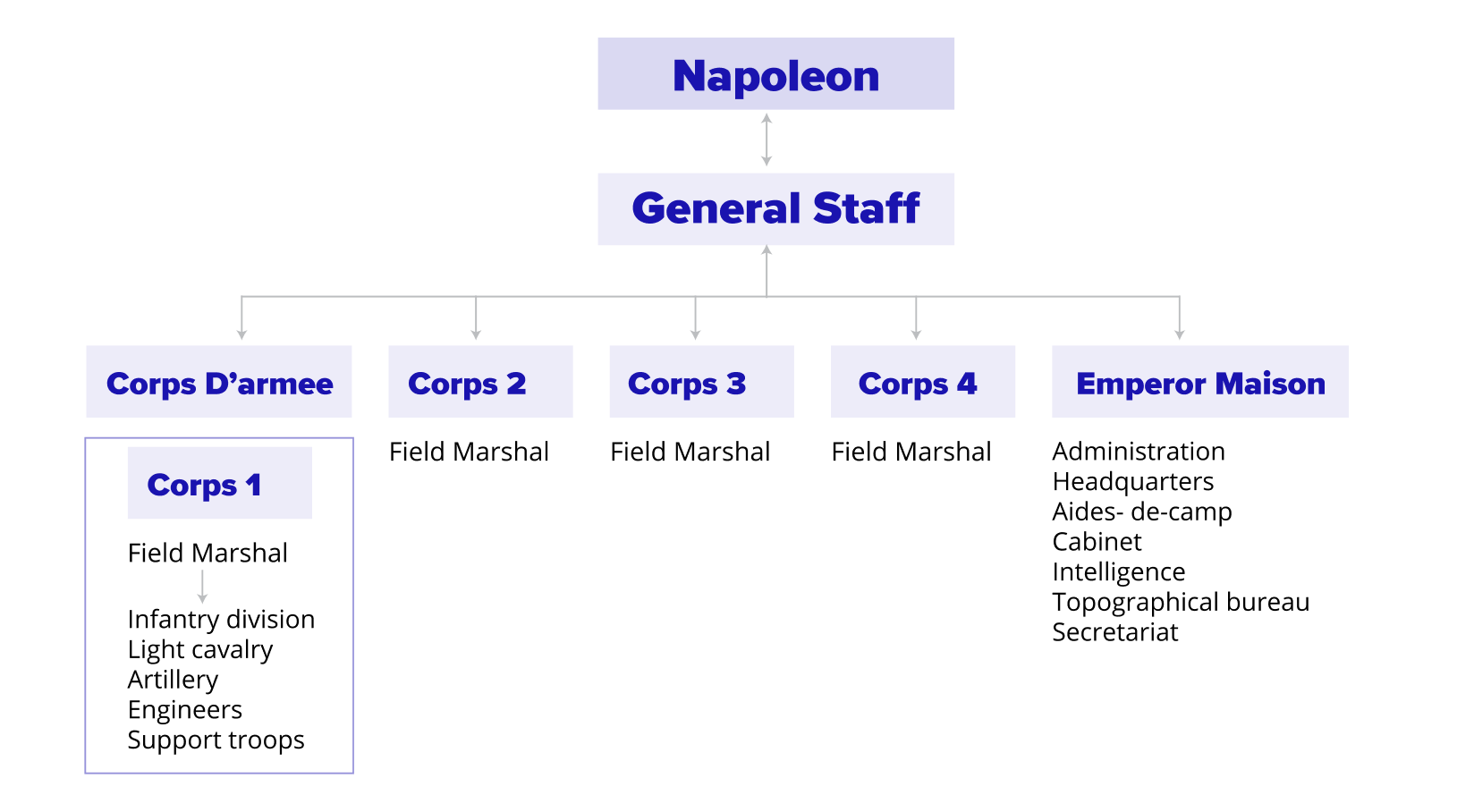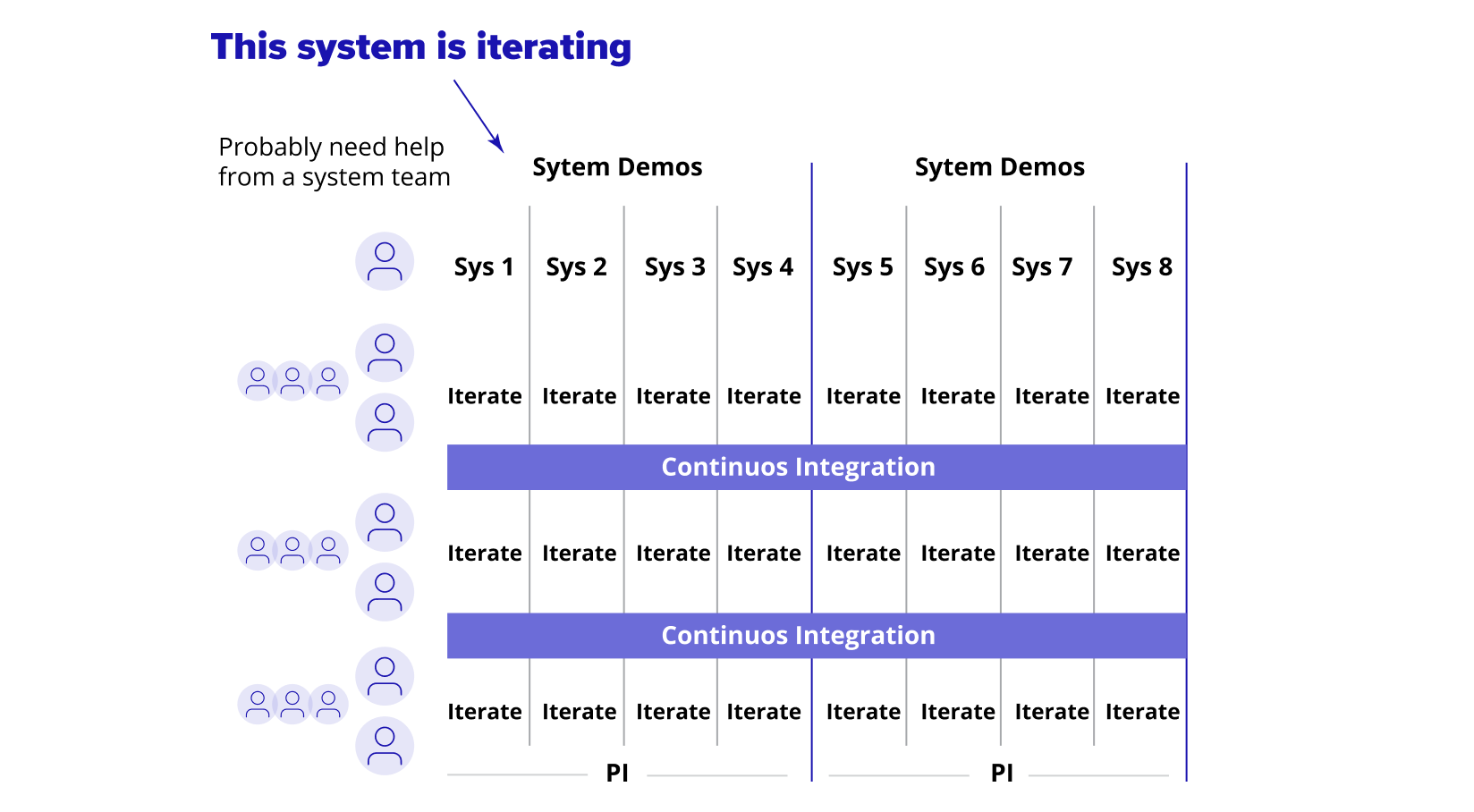Napoleon and the Scaled Agile Framework
The Agile movement, a project management and product development approach focused on iterative progress and flexibility, began over 20 years ago and has steadily gained popularity ever since. Despite its long history, Agile remains highly relevant and is being applied on an ever-larger scale in digital enterprises across industries. Moreover, there are historical cases where engineering teams successfully used similar management principles. A vivid example is Skunk Works and its 14 guiding principles, dating back to the 1940s, which partially overlap with Agile's core values.
This blog explores a historical analogy for the Scaled Agile Framework — a methodology based on Agile but applied at scale. The historical analogy lies in early 19th-century post-revolutionary France. The turmoil and innovations of that time shaped Europe for the next century, similar to how digital transformation is reshaping industries today for the decades ahead.

NAPOLEON – THE GREAT INNOVATOR
More than 200 years ago, France was ruled by Napoleon Bonaparte, an influential political and military leader. His reforms introduced groundbreaking innovations, laying the foundation for many aspects of the modern world. Napoleon’s military reforms were equally transformative, redefining warfare for generations to come.
As with any military conflict, the Napoleonic Wars brought chaos, suffering, and countless innocent lives lost. Without glorifying these wars, we aim to draw practical insights from Napoleon’s army (Grande Armée) and apply them to the challenges of Agile product development.

Lesson #1: The motivated individual
The post-revolutionary French Grande Armée achieved success in numerous battles, largely due to the character of its soldiers and officers. The French Revolution dismantled the entrenched social class system, opening military service to individuals from all social backgrounds. This merit-based organization fostered immense pride in the French Republic and its principles. Unlike other armies, which often consisted of unmotivated soldiers with no shared vision, the Grande Armée stood out for its unity and purpose.
Jacques Antoine Hippolyte, Comte de Guibert, an influential 18th-century military thinker, proposed the concept of citizen armies in 1770. He predicted that a national army would easily surpass mercenary forces and advocated for highly mobile, permanent divisions. Napoléon studied Comte de Guibert’s ideas and implemented these principles in the Grande Armée, placing significant emphasis on troop morale and welfare. Consequently, army regiments were retained after campaigns, fostering a strong sense of group identity — a practice that continues in many of the world’s armed forces today.
More than 200 years later, motivated individuals remain essential for success, particularly in the highly competitive digital industry. Historically, the software industry had a mixed reputation regarding employee motivation and engagement, as reflected in popular culture through examples like the Dilbert comics and the Hollywood movie “Office Space.” Over time, however, the industry adapted and introduced the Scrum methodology. Clear parallels can be drawn between the principles of Agile and those of the Grande Armée. Both emphasize self-motivated, cross-functional teams focused on a common goal, and both value long-term team cohesion. This approach contrasts with the earlier reliance on specialized professionals and temporary, project-based teams that dominated the software industry before 1990. Today, group bonding, mutual trust, unity, and cohesion remain vital in the digital economy.
Lesson #2: The cross-functional autonomous team
The foundation of the Grande Armée's organization was the army corps — a mix of infantry, artillery, a cavalry brigade, and engineers. Each corps worked independently, acting as a self-sufficient unit that could operate far from others with little oversight. However, the Grande Armée was not a strictly functional organization; for instance, there was no chief artillery marshal overseeing all artillery units.

In software development, the idea of cross-functional teams began with the Scrum methodology and later gained support from the DevOps movement. Despite widespread industry adoption and proven benefits, this approach has not been universally embraced — particularly by product development teams. Similar to the principles of the Grande Armée, the Scaled Agile Framework (SAFe) advocates avoiding functional silos. Forcing team members with programming skills to report to a development manager, while QA-skilled team members report to a QA manager, weakens team cohesion and performance. Conflicting loyalties are detrimental in both military organizations and digital product companies.
The corps system was designed to allow independent operation. Each corps functioned as a self-contained unit with its own leadership and internal command structure, but every commander knew the overall strategy and goals, ensuring their actions aligned with the broader mission. They had the freedom to decide the best course of action for upcoming battles.
This principle mirrors one of the Agile Manifesto’s core ideas: “The best architectures, requirements, and designs emerge from self-organizing teams.”
IT professionals adopt a similar approach in SAFe teams, which are largely autonomous and focused on outcomes rather than outputs. The overall direction for product development is guided by the business’s mission and vision, while priorities for new features are driven by customer needs. Decisions are made at the team level, empowering them to act with agility and purpose.
Lesson #3: Team coordination and cadence
The next innovation of the Grande Armée was its ability to coordinate movements and concentrate forces at decisive moments in battle. While each army corps had the autonomy to act independently, they maintained constant communication with headquarters. During active troop movements, every corps staff member produced daily reports, which were sent back to the general staff. After analyzing these reports, headquarters gave marching orders for the next day. This unique system allowed the Grande Armée to “march divided, fight united,” enabling the French to coordinate the movements of their corps across vast distances, outmaneuvering and confusing their opponents.
The concept of a “team of teams” is widely used to describe the collaboration of independent, autonomous groups working toward a shared goal. This naturally requires regular coordination of efforts, known as cadence. Agile Release Trains and cadence synchronization follow this same principle. Teams tackle technical uncertainties on their own (“march divided”), while the principle of continuous integration ensures the system evolves cohesively as a whole (“fight united”).

Ironically, the failure to effectively coordinate the efforts of multiple teams (army corps) was one of the key reasons for the defeat at Waterloo. While the French struggled to direct their movements, their adversaries outmaneuvered them, excelling at the very strategy the French had once mastered.
Lesson #4: The importance of a product owner
The stakes were immense for Napoléon — the fate of the French Republic hinged on the successes of the Grande Armée. Such was the pressure that Napoléon carried a packet of poison, prepared to take his own life rather than face capture. From a military perspective, Napoléon functioned as his own operations officer, relying solely on his strategic skills. He sought no counsel from his generals and bore the ultimate responsibility for every decision he made.
In software development, the SAFe methodology highlights the importance of a product owner. This person is responsible for managing the product backlog and ensuring the Agile team delivers the highest value. An effective product owner is a unique mix: someone who takes action, leads with vision, and works well with others.
However, organizations often struggle to find individuals with the right experience to excel in this role. A common misstep is replacing a single product owner with a committee of people, none of whom hold ultimate authority. This often leads to inefficiency, as meetings become bogged down by politics and internal disagreements.
Napoléon offers a historical parallel for the role of a strong product owner. He transformed post-revolutionary France into a unified nation with a stable economy and a world-class army. During his military campaigns, Napoléon acted as the product manager of his operations, making swift, decisive tactical decisions. In contrast, his enemies — coalitions of monarchies — often lacked unity. Much like product owner committees, these coalitions often got caught up in endless negotiations and internal conflicts, which made them less agile and effective.
Lesson #5: The release train engineer and the general staff
A critical component of the Grande Armée’s organization was its general staff, which served as the backbone of its command-and-control network. Led by Marshal Berthier, the general staff included a team of highly skilled officers who provided essential information for military planning. For instance, Berthier’s aides gathered intelligence on road conditions, town layouts, and the quality of equipment carried by enemy forces. The chief of staff’s responsibilities included maintaining situation reports, sending orders, keeping the army’s war diary and maps, maintaining registers, and conducting inspections.
At the time, the general staff’s primary role was to acquire, analyze, and share information internally before taking action. In the SAFe, there is no direct equivalent to the general staff. Instead, its functions are distributed across roles such as the system architect/engineer, release train engineer, and the system team. Additional coordination is achieved through practices like Scrum of Scrums and Product Owner Sync. In SAFe, analyzing and sharing information is part of every role, rather than being handled by one central entity.
Unlike Napoleonic times, the SAFe promotes continuous learning at all levels, not just at the top. This decentralized approach fosters agility and innovation throughout the organization.
THE HUMAN FACTOR IN DIGITAL TRANSFORMATION
The digital enterprise demands a new organizational design, and companies face significant challenges in adopting new ways of working. Digital value delivery requires a paradigm shift — from project-based, top-down, batch-oriented processes to continuous, bottom-up, and emergent product development.
Achieving this transformation requires a delicate balance between agile development methods, traditional enterprise architecture practices, and software architecture. However, there is no universal formula or practice that fits every business, as each context is unique. At SoftServe, we have successfully implemented multiple product development initiatives using the SAFe methodology. Yet even the best methodology will fail without the most critical resource — human capital.
Napoléon famously believed that success in military campaigns was 75% “esprit de corps” — the shared pride, loyalty, and camaraderie among troops — and only 25% dependent on troop numbers and equipment quality. Over 200 years later, the Agile Manifesto echoed this sentiment with the principle: “Build projects around motivated individuals. Give them the environment and support they need, and trust them to get the job done.”
SoftServe combines expertise in Agile teams and product innovation to transform traditional IT enterprises into high-performing, future-ready businesses. Together, we build a future where innovation and excellence are not just goals but the hallmarks of your success.
 Start a conversation with us
Start a conversation with us

